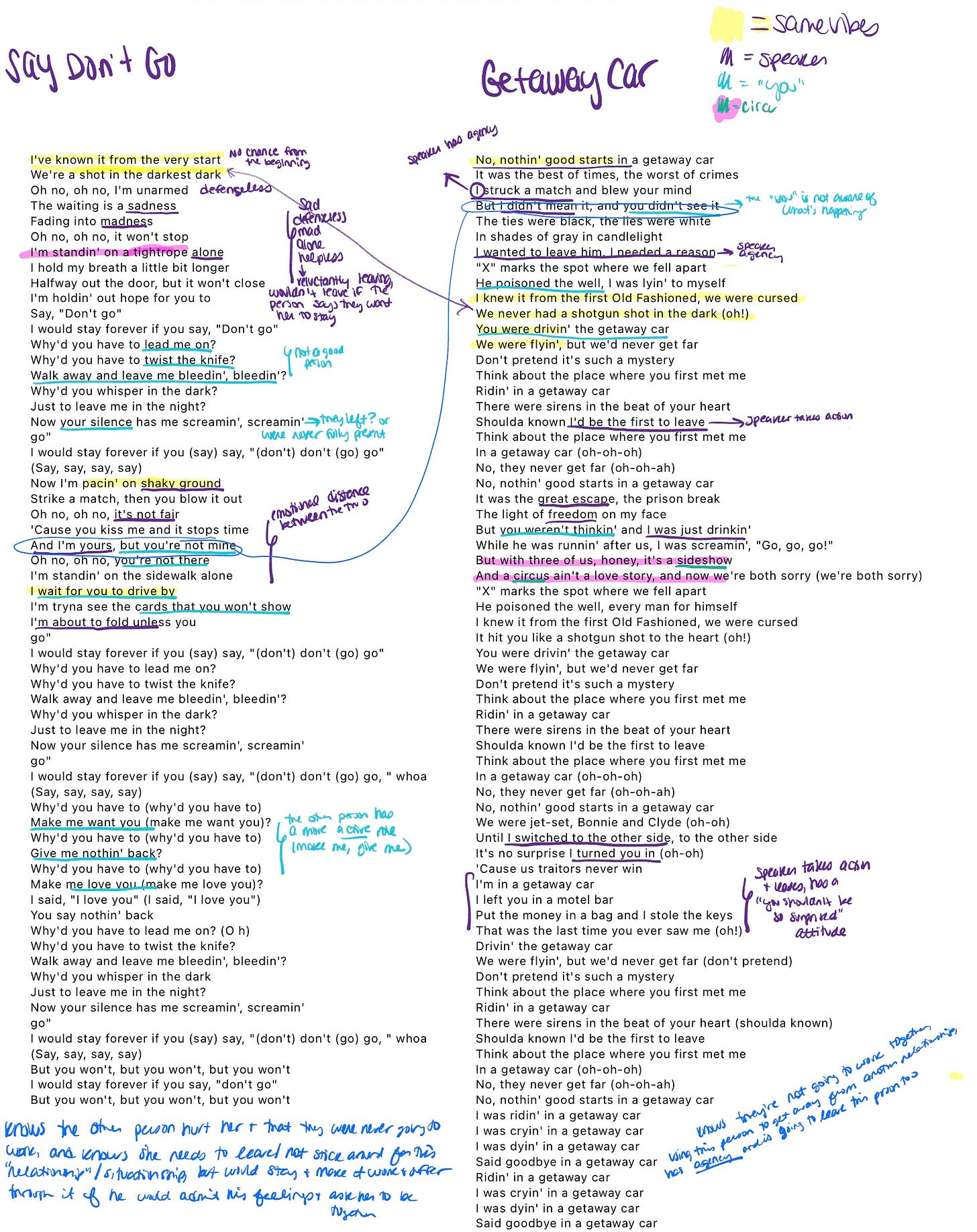I’ve known it from the very start…nothing good starts in a getaway car: Comparing "Say Don’t Go" and "Getaway Car"
New episode: "Say Don't Go" deep dive out now!
This week, we're deep diving into "Say Don't Go," from 1989 (Taylor’s Version (From the Vault). Picking up from last week's circus-themed episode, we unravel how Taylor crafts a lyrical nightmare of helplessness, packed tight with metaphors and rhetorical questions that leave listeners suspended in emotional free fall.
🎧 Listen above and ⬇️ scroll below to read Jodi’s comparison of “Say Don’t Go” and “Getaway Car”
✨ We want to hear from you! ✨
Whether you listen weekly, read occasionally, or just joined us—this quick survey helps us understand who’s here and how to make the podcast + newsletter even better. It takes 5 minutes, and we’d be so grateful for your input.
🎥 Sneak Peek
Catch excerpts from the podcast and behind-the-scenes content on YouTube, TikTok, and Instagram.
📜 This Week’s Extra Credit by Jodi
When archaeologists uncover new Egyptian tombs, we suddenly have a new piece of information that helps us go back and better understand all the other artifacts previously uncovered. This discovery helps us see a connection in all previous Egyptian artifacts we hadn’t seen before.
Similarly, when Taylor Swift releases a vault track as part of her re-recordings, we suddenly have new songs and lyrics from a long-ago era that help provide context for future albums or that reveal a previously unknown connection between songs. (Why yes, I did just compare Taylor Swift to ancient Egypt, as both are instrumental in understanding modern society.)
Our deep dive of 1989 (Taylor’s Version) (From The Vault) track “Say Don’t Go” this week provided one such connection and illumination: Jenn brought up lyrics from another pod and Swiftie favorite “Getaway Car”
“I’ve known it from the very start, we’re a shot in the darkest dark” - “Say Don’t Go”
“I knew it from the first Old Fashioned we were cursed, we never had a shotgun shot in the dark.” - “Getaway Car”
Naturally, I needed to do a full lyrical comparative literature assessment to see what else I could learn about the potential connection between these two songs.
“I’ve known it from the very start…nothing good starts in a getaway car”
The repetition of the idea of a relationship being a “shot in the dark” from the start doesn’t necessarily mean these two songs are connected. We know from the release of her diaries and journals during the Lover era that Taylor often jots down lyrics and phrases years in advance, hoping to find a home for them at some point in the future. It’s possible that Taylor first used this idea in “Say Don’t Go,” but when the song didn’t make the album, she saw an opportunity to reuse it for her next album in “Getaway Car.” It doesn’t mean the songs are connected, but it does serve the same purpose in both songs: this was doomed from the beginning. It creates a nice dramatic tension in both songs—why would you bother with something you know couldn’t work? Despite the similar beginning, both stories take vastly different turns and find the speakers in different positions.
“Why’d you have to lead me on….I wanted to leave him, I needed a reason.”
“Say Don’t Go” finds the speaker knowing this relationship would never work, understanding this person has led her on and has hurt her, and that she needs to leave, but admitting that she’d stay if he’d ask her to. The speaker is leaving reluctantly, left sad, alone, and helpless. It’s the other person who’s taking all the action (all of it bad, mind you): “lead me on,” “twist the knife,” “walk away and leave me bleedin’”).
In “Getaway Car,” however, the speaker WANTS to leave. She first wants to leave the “him,” whom we presumed in our “Getaway Car” deep dive is a previous relationship; then the speaker “switch[es] to the other side” and wants to leave the “you” she’s with. This speaker has agency and takes action. She’s in charge the whole time; she’s never a bystander or a passenger in the relationship, even when she’s a passenger in the getaway car.
“You were drivin’ the getaway car….I wait for you to drive by”
Our “Say Don’t Go” speaker is helpless, and our “Getaway Car” speaker has agency. It makes sense then that cars play two VERY different roles in these songs: Our “Say Don’t Go” speaker is “standin’ on the sidewalk alone / I wait for you to drive by.” She’s left behind, stranded, waiting for someone else to take action. Whereas “Getaway Car” has our speaker in the car the entire time—first as a backseat driver, directing the “you” to drive, before stealing the key and driving away herself. The car is an escape vehicle, a symbol of her agency, instead of a symbol of being left behind in “Say Don’t Go.”
“And I’m yours but you’re not mine…I didn’t mean it, and you didn’t see it”
These lines, to me, summarize the differences in the speakers, and therefore the differences in these two songs:
“And I’m yours by your not mine”: There’s emotional distance between the speaker and the object of her affection, leaving our speaker dejected and alone. It’s depressing and the opposite of empowerment.
“I didn’t mean it, and you didn’t see it”: The speaker is in total control, emotionally and otherwise. The “you” can’t even see what’s going on; they’re either blinded by love or just oblivious.
These songs seem to be in conversation with one another—the speaker in “Say Don’t Go” could be the “you” in “Getaway Car.” Think about it: she’s left behind, alone, feels like she was led on, and left behind waiting for the other person to drive by. That’s pretty much how we see the “you” in “Getaway Car”: they were left behind when the speaker took the car, felt more deeply or more seriously about the speaker than the speaker did about them.
Whether or not “Say Don’t Go” and “Getaway Car” are canonically linked, what they do reveal is how Taylor uses repeated imagery to explore very different emotional terrains—sometimes we’re stranded on the sidewalk, and sometimes we’re driving the narrative. What do you think—are these songs talking to each other?









